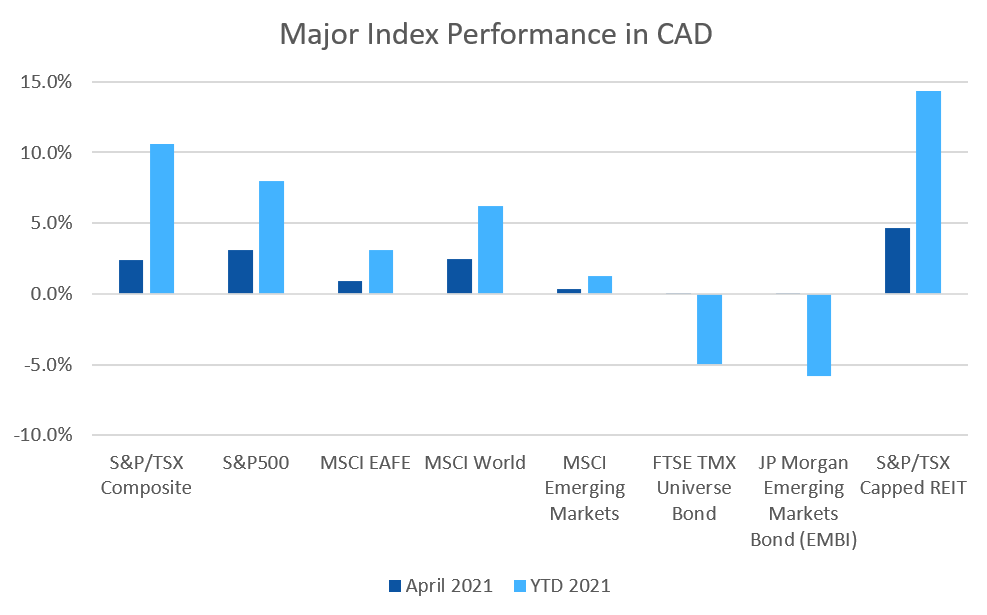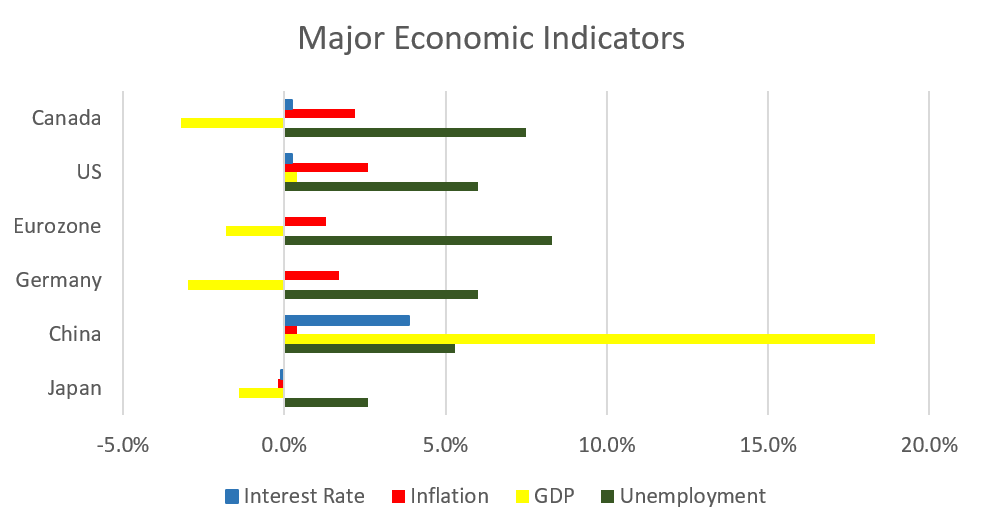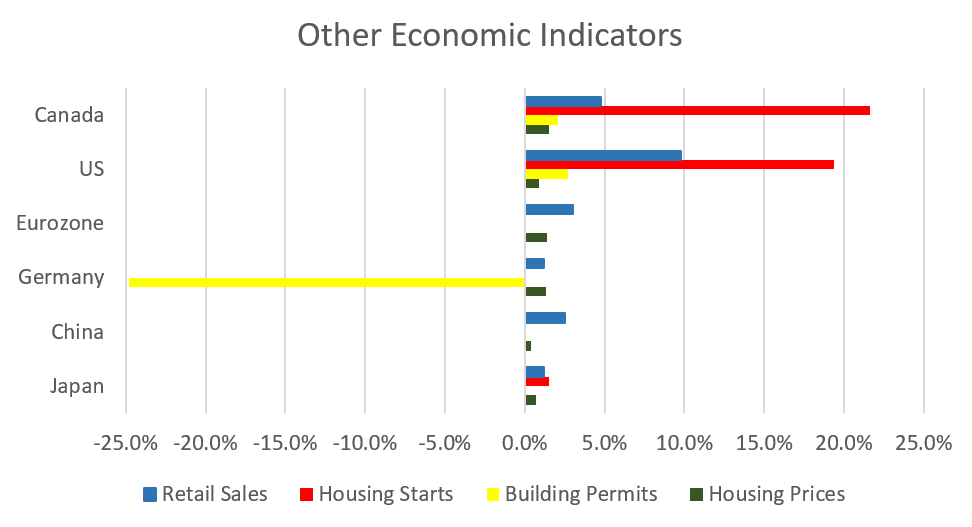April was another strong month for equity markets, while fixed income had a flat month.
April 2021 Market Performance
All index returns are total return (includes reinvestment of dividends) and are in Canadian Dollars unless noted.
| Other Market Data | Month-end Value | Return for April 2021 | 2021 YTD Return |
|---|---|---|---|
| Oil Price (USD) | $63.48 | +7.30% | +30.83% |
| Gold Price (USD) | $1,768.60 | +3.20% | -6.68% |
| US 3 month T-bill | +0.01% | -0.02%* | -0.08%* |
| US 10 year Bond | +1.65% | -0.09%* | +0.72%* |
| USD/CAD FX rate | 1.2285 | -2.31% | -3.51% |
| EUR/CAD FX rate | 1.4798 | +0.26% | -5.19% |
| CBOE Volatility Index (VIX) | 18.61 | -4.07% | -18.20% |
*Absolute change in yield, not the return from holding the security.
April was another strong month for equity markets, while fixed income had a flat month.
The S&P/TSX Composite was up +2.4% in April, hitting new all time highs. The TSX Comp. is now up more than 10% for 2021. The S&P/TSX Small Cap was up +5.1% for the month, and is up +13.7% for 2021. In the US, equity market performance was also strong. The large cap S&P500 was up +5.3% (+11.8% for 2021) while the small cap Russell 2000 index was up +2.1% for April and +14.8% for 2021.
The broad index of EAFE (Europe, Australasia & Far East) stocks was up +1.0% (+8.0% for 2021), European stocks were up +2.0%, and British stocks were up +3.8% for April. For 2021 European and British stocks are up +9.1% and +7.9%, respectively. Japanese stocks were one of the few losing markets in April, down -1.3%. Emerging market stocks were up +1.5% for the month, and are one of the laggards for 2021, up +5.0%.
Bonds stopped their slump in April. The major Canadian bond index, the FTSE/TMX Universe Bond Index, was flat in April while the FTSE/TMX Short-term Bond Index was up +0.2%. US investment grade bonds did better; the ICE BoA AAA and BBB indexes were up +1.5% and +1.2% respectively for April. High yield was up +1.1% for HY Master II and +1.3% for the CCC and lower (the real junky stuff) Index. Emerging market bonds were flat.
REITs had another good month, gaining +4.6% in April and are up +14.3% for 2021.
Oil had a strong month, gaining +7.3% in April. For 2021 oil is now up +30.8%. Gold was up +3.2%, and is now down -6.7% for 2021. With oil making up a large part of the diversified Bloomberg Commodities Index, it returned +8.3% for April and is up +15.8% in 2021.
In April, the Canadian Dollar (CAD) gained +2.3% against the US Dollar, and lost -0.3% against the Euro.
April 2021 Economic Indicator Recap
Below are the readings received in April for the major economic indicators: central bank interest rates, inflation, GDP and unemployment.
Below are the current readings on a few other often followed economic indicators: retail sales and housing market metrics.
A Closer Look at the Canadian Economy
Canada’s unemployment rate dropped to 7.5% in March, the lowest rate since February 2020. The economy gained 303,100 jobs during the month, 175,300 were full time jobs and 127,800 were part time jobs. Employment rose in most provinces
Housing prices across Canada were up +1.5% in March. Halifax was again the top performer, gaining +3.3%, followed by Hamilton (+2.8%), and Toronto (+1.9%). It was the first time since November 2020 that all 11 major markets were positive.
The level of new housing starts surged +21.6% to a record high of 335,200 in March, well ahead of CMHC forecasts of 250,000. Urban housing starts rose +24.4%. Building permits rose +2.1% to a new all-time high $10.2 billion, as non-residential construction permits rose +14.2% to $3.3 billion, while residential construction slipped -2.9% to $6.8 billion.
The inflation rate for March was +0.5%, and +2.2% on an annual basis. Core inflation which excludes more variable items such as gasoline, natural gas, fruit & vegetables and mortgage interest was +1.4%. The annual inflation rate was the highest reading since the pre-pandemic reading in February 2020. The rise in inflation was attributed mostly to higher gasoline prices (+35%) and housing (+2.4%).
Retail sales were up +4.8% in February, the largest increase since June 2020. Sales increased in 9 of 11 sectors, led by car and parts dealers and gas stations. Sales also increased at general merchandise stores and clothing stores. Compared to a year ago, retail sales were up +6.0%.
Canada’s GDP was up +0.4% in February, the tenth consecutive monthly gain since the biggest contraction on record in March and April. Collectively the services sectors rose +0.6%, while the goods producing sectors contracted by -0.2%, the first contraction since April 2020. 14 of 20 industrial sectors posted gains in February; mining, quarrying, and oil and gas extraction, and manufacturing were among the sectors posting declines.
As expected, the Bank of Canada left its benchmark interest rate at 0.25% at the April 21st meeting. The benchmark interest rate is expected to remain at its current low level until into 2022. The BoC reduced quantitative easing program of purchasing at least $4 billion of government and corporate bonds per week to $3 billion per week.
*Sources: MSCI, FTSE, Morningstar Direct, Trading Economics



